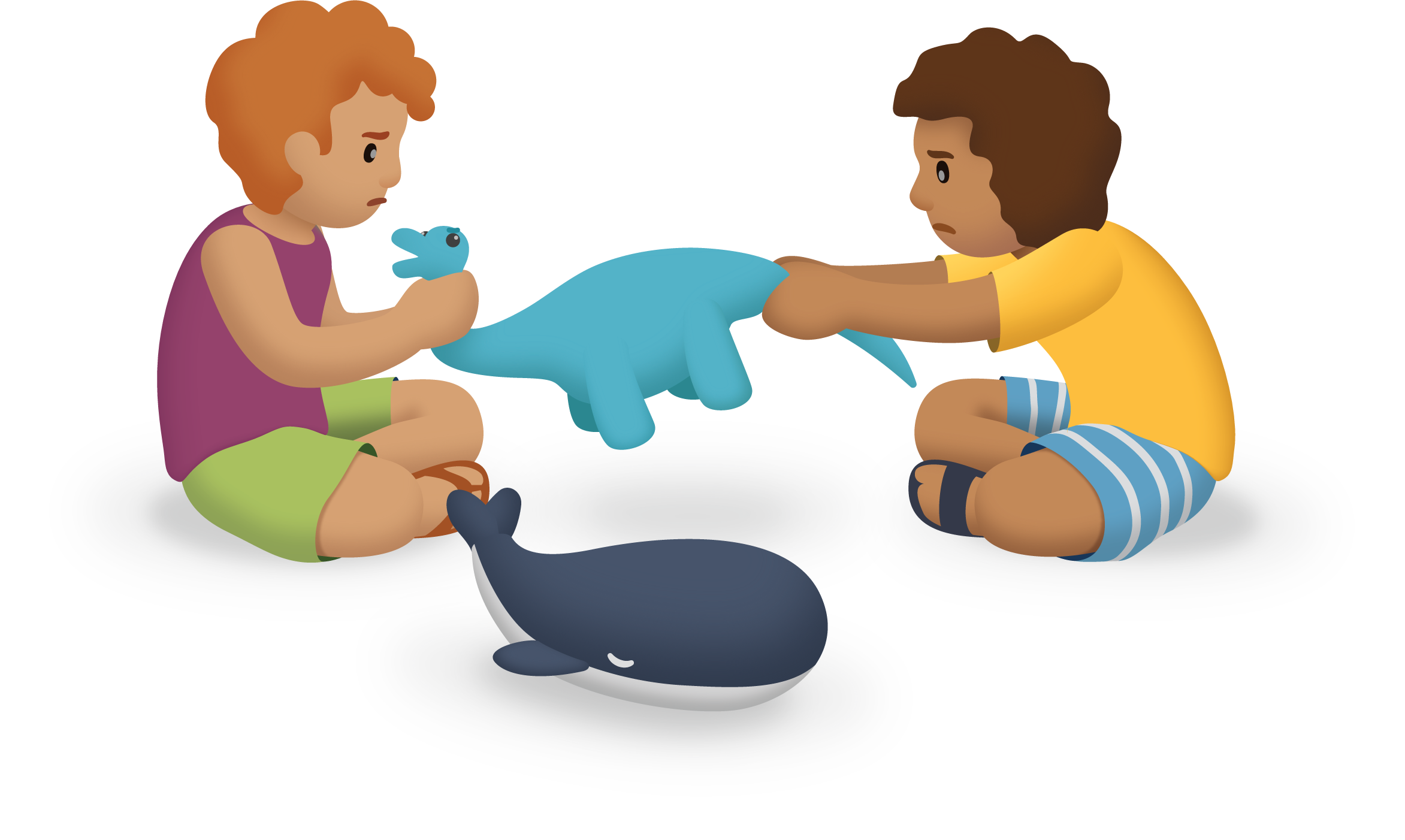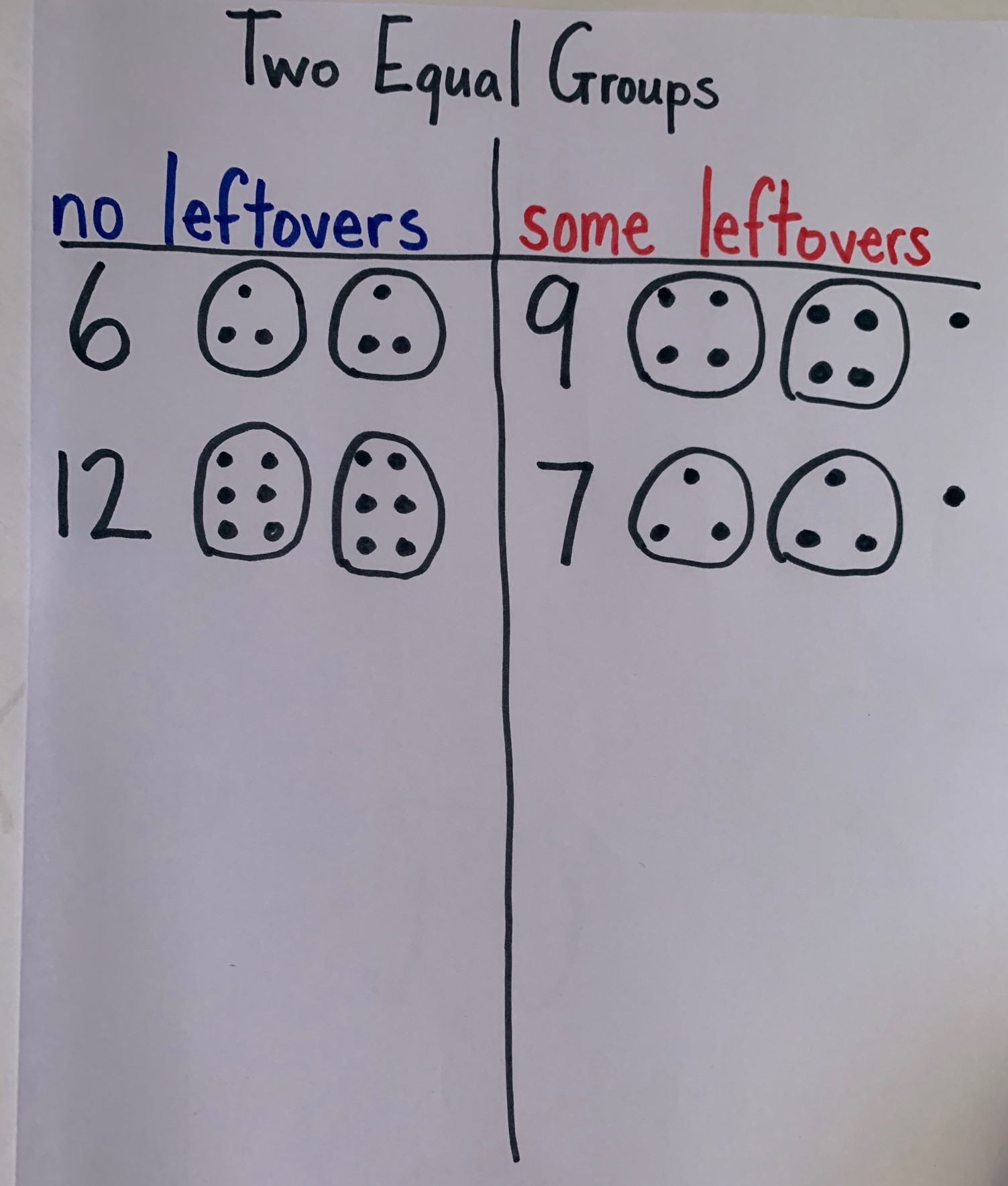Lesson 1
Can You Share?
Warm-up: Notice and Wonder: Sharing is Caring (10 minutes)
Narrative
Launch
- Groups of 2
- Display the image.
- “What do you notice? What do you wonder?”
- 1 minute: quiet think time
Activity
- “Discuss your thinking with your partner.”
- 1 minute: partner discussion
- Share and record responses.
Student Facing
What do you notice? What do you wonder?

Student Response
For access, consult one of our IM Certified Partners.
Activity Synthesis
- “If these children are fighting over the toy, how could they resolve their problem?” (One could play with the other toy, so they both have one to play with. They could take turns playing with the dinosaur.)
- “Today we are going to look at ways to share groups of objects equally.”
Activity 1: My Fair Share (20 minutes)
Narrative
The purpose of this activity is for students to share a collection of objects with a partner so that both students receive the same amount and as many objects as possible. They separate groups of objects into 2 equal groups and identify numbers of objects that can be split into 2 equal groups with “no leftovers” and those that can be split into two equal groups with “some leftovers.” In the synthesis, students discuss that numbers with “some leftovers” can only have 1 leftover. Create a t-chart that lists the numbers that students find for each category. Students will add more to the t-chart in the next lesson.
When students notice that some collections of objects can be shared equally while others can not they observe an important mathematical structure (MP7) which they will name in a future lesson.
This activity uses MLR8 Discussion Supports. Advances: speaking
Supports accessibility for: Organization, Visual-Spatial Processing
Required Materials
Materials to Gather
Required Preparation
- Each group of 2 needs a container of counters with 4 to 15 counters in each container. These containers will be used again in the next lesson.
- Create a t-chart on a large piece of chart paper to display in the activity synthesis.
- Use “Two Equal Groups” as the title.
- Label the t-chart with “no leftovers” and “some leftovers” as the categories.
Launch
- Groups of 2
- Give each group 1 container of objects.
Activity
- “Share the objects in your container with your partner so that you each get the same amount and as many as possible.”
- “Record the total number of objects that were in your container.”
- “Then record the number of objects in your share and in your partner’s share. If there are any left over, record the number in the chart.”
- Demonstrate with the dinosaur example from the warm-up as needed.
- “When you finish sharing the objects in one container, pack up the objects and trade with another group.”
- 10 minutes: partner work time
Student Facing
Choose a container of counters. Share the counters equally with your partner. Then complete the table to show the total number of objects and how many you each received.
| total | my share | my partner’s share | number of leftovers |
|---|---|---|---|
Student Response
For access, consult one of our IM Certified Partners.
Activity Synthesis
- Display t-chart labeled “Two Equal Groups” with “no leftovers” and “some leftovers” as the categories.
- Invite students to share a total amount and whether they made 2 equal groups with no leftovers or 2 equal groups with some leftovers.
- Record the total in the appropriate column of the chart.
- Ask students to share the number in their share and in their partner’s share. Record by drawing a circle around each share. For example:

- Repeat to gather 2–3 examples of even and 2–3 examples of odd numbers.
- “Look at the numbers in each group. What do you notice? What do you wonder?” (I notice all the numbers show two equal groups. I notice there’s only ever one leftover. I notice some numbers have the same equal groups, like 6 has 2 groups of 3 and 7 has 2 groups of 3. I wonder why there’s only ever one leftover.)
MLR8 Discussion Supports
- Before students share, remind students to use words such as equal groups and leftovers.
- 1 minute: quiet think time
- 1–2 minutes: partner discussion
- Share responses.
- If needed, “How many leftovers did each number have?”
- “Whenever we put objects into 2 equal groups, we will either have 0 leftovers or 1 leftover.”
Activity 2: Share the Marbles (15 minutes)
Narrative
Required Materials
Materials to Gather
Launch
- Groups of 2
- Give students access to connecting cubes or counters.
- “Andre has a collection of 17 marbles. He wants to play a game with his sister. To play, they both need to start with the same number of marbles and they want to use as many as they can.”
- “Use the counters, diagrams, symbols or other representations to show how they could start the game.”
- 2 minutes: independent work time
- Monitor for different ways students group the counters or objects in the diagrams they create.
- “Compare your thinking with your partner.”
- 1 minute: partner discussion
- Invite previously identified students to share their solutions. Display or record their grouping strategy.
- Display or draw:
\(17 = 8 + 8 + 1\)
- “How does the equation represent this diagram?” (17 is the total amount. Each 8 shows the group of 8 on top and the group of 8 on the bottom and his sister got the same amount. The + 1 shows the marble that is left out.)
Activity
- “Work with your partner to answer the other questions about Andre’s marbles.”
- 8 minutes: partner work time
Student Facing
Andre has a collection of 17 marbles. He wants to play a game with his sister. They both need to start with the same number of marbles and they want to use as many as they can.

- How many marbles would Andre and his sister get? Would there be any marbles left out of the game? Show your thinking.
-
What if Andre had 18 marbles? How many would each person get? Would there be any marbles left out? Show your thinking.
- What if Andre had 20 marbles? How many would each person get? Would there be any marbles left out?
Student Response
For access, consult one of our IM Certified Partners.
Activity Synthesis
- Invite 1–2 students to share their response for 18 marbles.
- Display a student representation or draw:

- “How did you use your work for sharing 18 marbles to find out how to share 20 marbles?” (20 is just 2 more than 18 so each group would get 1. There wouldn’t be any left over.)
- Display a student representation for 20 marbles or draw to show adding 1 marble to each group to the drawing of 18 marbles.
- “What equation can we write to represent the diagram?” (\(10 + 10 = 20\))
Lesson Synthesis
Lesson Synthesis
Draw 12 circles or arrange 12 counters in the following configurations:



“Which representations help you see if 12 blocks could be split into two equal groups?” (A because you can see that they each have the same amount because there are two groups and the circles in each group are matched up. C because you can see the 2 groups and there are the same amount in each group.)
Cool-down: Share with Your Partner (5 minutes)
Cool-Down
For access, consult one of our IM Certified Partners.
